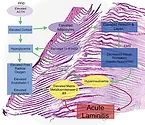Advertise Follow Us
Derrick Cooke
Derrick Cooke, CJF, has been a farrier for over 37 years. He studied biology and chemistry in college and is an American Farrier’s Association certification tester who has lectured at several clinics around the world. He has worked extensively for the past 15 years to develop practical solutions for laminitis.
ARTICLES
Higher ACTH levels can lead to hyperinsulinemia and laminitis despite high-quality care
Read More
Top Articles
Current Issue
American Farriers Journal
American Farriers Journal is the “hands-on” magazine for professional farriers, equine veterinarians and horse care product and service buyers.
Current Issue
Special Report For Equine Veterinarians
American Farriers Journal is the “hands-on” magazine for professional farriers, equine veterinarians and horse care product and service buyers.
Must Read Free Eguides
Download these helpful knowledge building tools
- Caring for Your Horse During a Pandemic
- CBD Products Have Promise for Farriers, but Buyer Beware
- Sharpening Knives with a Buffer
- Winter Hoof Care
Videos
2025 Farrier Beard of the Year Winner: Frank Bevacqua
With a 15-inch-long beard that’s been growing for 15 years, New Jersey farrier Frank Bevacqua has been selected as the American Farriers Journal “2025 Farrier Beard of the Year” winner.
Events
Lookout Mountain School of Horseshoing will Host Annual Clinic
Date: 10/18/25
Location: Gadsden, AL
View Event
Top Directory Listings
Life Data Labs Inc
Life Data Labs Inc. is a dedicated product manufacturer committed to producing premium quality animal nutrition and health products through continuous product improvement and new product development. First-class ingredients, fresh products, consistent high quality and scientifically proven effectiveness are the principal features of Life Data Labs animal health products. And that's why they've produced the #1 recommended hoof supplement by farriers for 12 consecutive years.
Kawell USA
Kawell develops and produces copper alloy horseshoes and inserts, giving horses the care that they need to fight issues associated with white line disease, seedy toe and thrush.
SmartPak
From the feed room to the tack room, SmartPak offers innovative solutions to help riders take great care of their horses. SmartPak was founded in 1999 with the introduction of the patented SmartPak™ supplement feeding system. The revolutionary, daily dose SmartPaks are custom-made for your horse, individually labeled and sealed for freshness.








